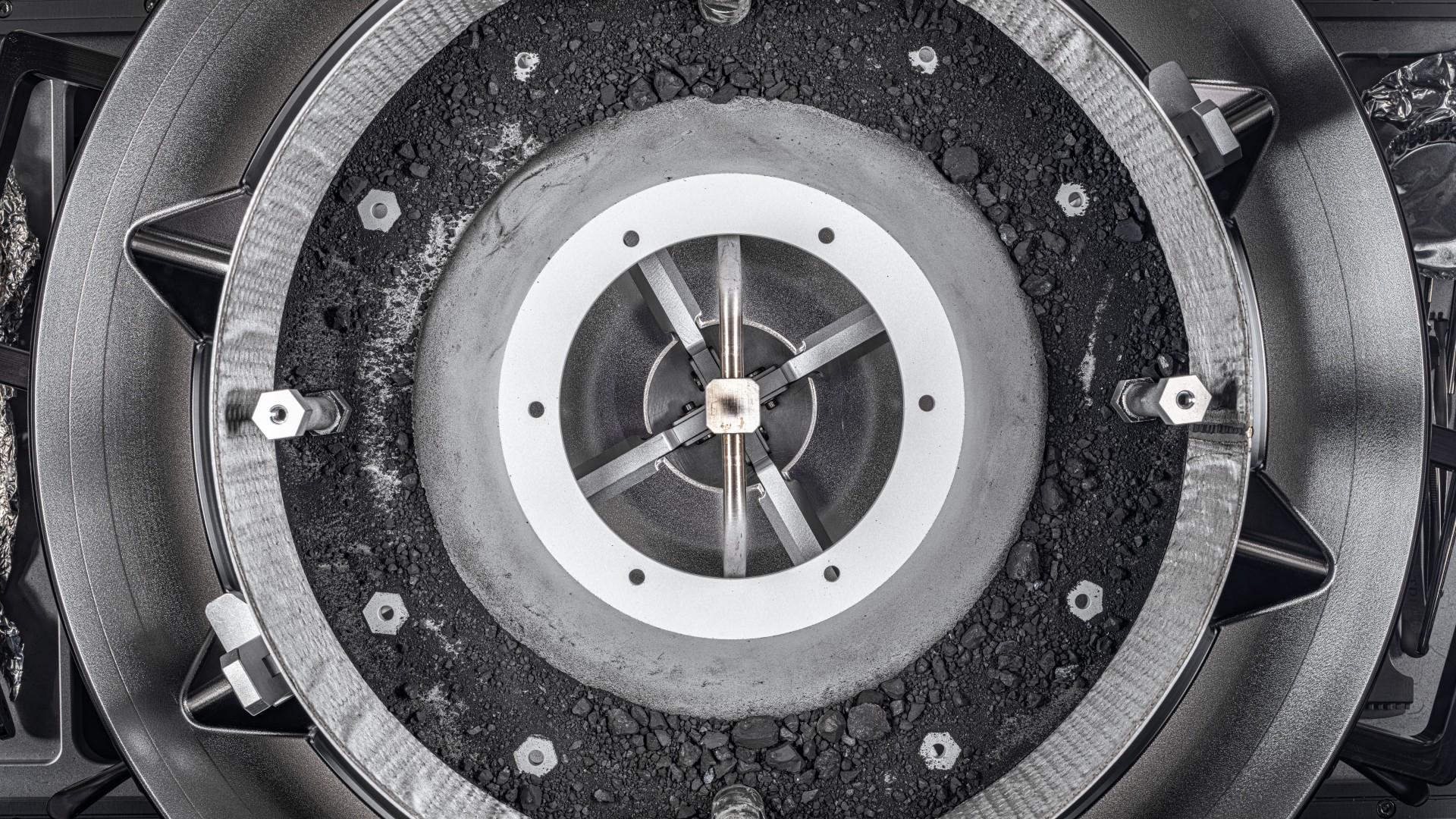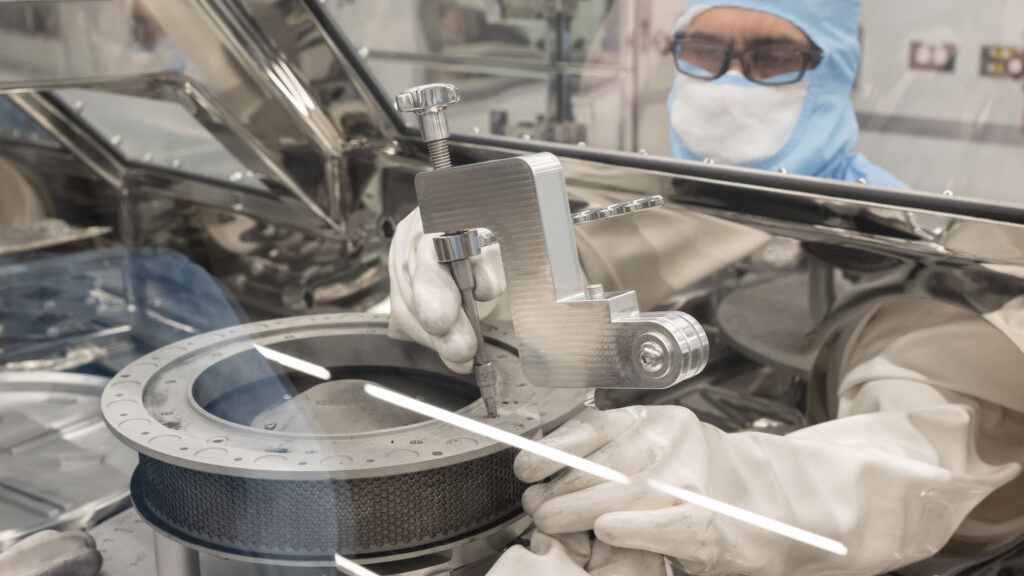NASA finally opens OSIRIS-REx asteroid sample canister after freeing stuck lid
NASA's OSIRIS-REx sample capsule begins to reveal its secrets.

It's finally open. After months of anticipation, NASA's OSIRIS-REx mission has achieved a significant milestone by successfully accessing the treasure trove of asteroid material that the probe collected during its billion-mile journey.
On January 10, a group of NASA technicians finally removed two stubborn fasteners that had locked away the precious cargo, allowing scientists unprecedented access to the asteroid material, according to a NASA statement.
The OSIRIS-REx spacecraft made history in September 2023 when it became the first U.S. mission to return an asteroid sample to Earth. The sample was stored securely within a return capsule, tantalizingly close but out of reach due to two stuck fasteners that the team's limited number of approved tools were unable to pry open.
Related: NASA's 1st asteroid sample is rich in carbon and water, OSIRIS-REx team finds
While 70.3 grams (2.48 ounces) of material had already been accessed from the outside of the sampler head, known as the Touch-and-Go Sample Acquisition Mechanism (TAGSAM), the bulk of the asteroid sample material remained trapped within the capsule.
According to NASA's statement, the bulk of the asteroid material is now accessible after two of the 35 fasteners on TAGSAM that could not be removed using the existing tools approved for use inside the OSIRIS-REx sample container were finally freed.

With the fasteners finally removed, the astromaterials curation team at NASA's Johnson Space Center in Houston will proceed with disassembling the TAGSAM head to access the remaining asteroid material. This material includes dust and rocks of up to about 0.4 inches (one cm) in size. The final mass of the sample will be determined in the coming weeks.
Get the Space.com Newsletter
Breaking space news, the latest updates on rocket launches, skywatching events and more!
NASA plans to release a catalog of all the Bennu samples later this year, which will enable scientists and institutions worldwide to submit requests for research or display, opening up new avenues of scientific exploration.
Asteroid Bennu, believed to be a primitive space rock dating back to the early days of our solar system, has the potential to provide invaluable insights into the formation and evolution of celestial bodies. Studying samples collected from its surface could unlock essential clues about our cosmic neighborhood, furthering our understanding of the universe's mysteries.
The OSIRIS-REx spacecraft that collected the samples, meanwhile, has changed names and missions. Now called OSIRIS-APEX, the probe is on a five-year journey to study the asteroid Apophis— named after the ancient Egyptian god of chaos— as it approaches our planet.
Join our Space Forums to keep talking space on the latest missions, night sky and more! And if you have a news tip, correction or comment, let us know at: community@space.com.
John is a science and technology journalist and Space.com contributor. He received his B.A. in English and his M.A. in Computer Science from the City University of New York, Brooklyn College, and has bylines with TechRadar, Live Science, GamesRadar, and other publications. You can find him on Bluesky at @johnloeffler.bsky.social or seeking out dark sky country for spectacular views of the cosmos.
-
vilonia Reply
What, no gold?Admin said:After months of anticipation, NASA's OSIRIS-REx mission team has successfully accessed the treasure trove of asteroid material the probe collected during its billion-mile journey.
NASA finally opens OSIRIS-REx asteroid sample canister after stuck lid issue : Read more -
DrRaviSharma I would like to know more about the precautions NASA is taking for making sure that there is no bio-active material in the canister and if it is, then it is isolated from earth atmosphere. We can only rely on our knowledge of life components after GENOME mappings etc.Reply
Second thing I would like to know is whether there are any plans by NASA, Scripps Inst., La Jolla or UCSD to study geocosmochronology like micro-meteoritic history and origin of embedded micrometeorites in the Asteroid samples. For this a special team with this subject's terrestrial knowledge largely acquired by samples of micrometeorites from the ocean floors is required and hope it is active among the PIs.
Looking forward beyond Moon meaningfully constructing a good solar system and beyond model!
Best Wishes.
Ravi
(Dr. Ravi Sharma, Ph.D. USA)
NASA Apollo Achievement Award
ISRO Distinguished Service Awards
Former MTS NASA HQ MSEB Apollo
Former Scientific Secretary ISRO HQ
Ontolog Board of Trustees
Particle and Space Physics
Senior Enterprise Architect
SAE Fuel Cell Tech Committee voting member for 20 years.
http://www.linkedin.com/in/drravisharma -
Zdad Reply
NASA engineers brushed aside two stale Cheetos, an old beer can pull tab and a few small dust bunnies before reaching the prized sample....vilonia said:What, no gold?









